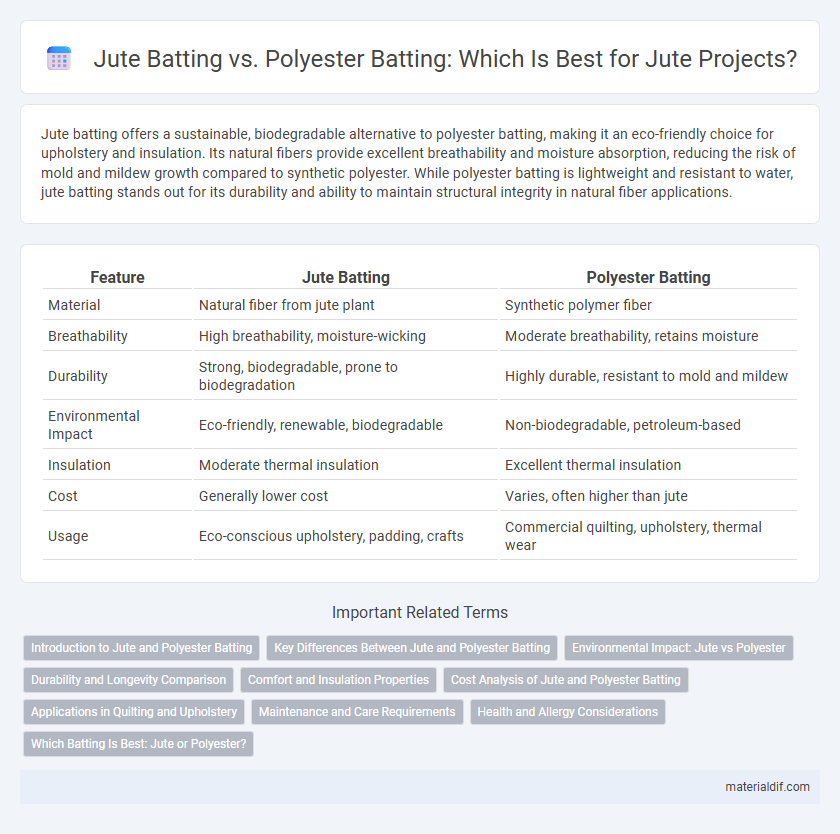Jute batting offers a sustainable, biodegradable alternative to polyester batting, making it an eco-friendly choice for upholstery and insulation. Its natural fibers provide excellent breathability and moisture absorption, reducing the risk of mold and mildew growth compared to synthetic polyester. While polyester batting is lightweight and resistant to water, jute batting stands out for its durability and ability to maintain structural integrity in natural fiber applications.
Table of Comparison
| Feature | Jute Batting | Polyester Batting |
|---|---|---|
| Material | Natural fiber from jute plant | Synthetic polymer fiber |
| Breathability | High breathability, moisture-wicking | Moderate breathability, retains moisture |
| Durability | Strong, biodegradable, prone to biodegradation | Highly durable, resistant to mold and mildew |
| Environmental Impact | Eco-friendly, renewable, biodegradable | Non-biodegradable, petroleum-based |
| Insulation | Moderate thermal insulation | Excellent thermal insulation |
| Cost | Generally lower cost | Varies, often higher than jute |
| Usage | Eco-conscious upholstery, padding, crafts | Commercial quilting, upholstery, thermal wear |
Introduction to Jute and Polyester Batting
Jute batting, derived from the natural fibers of the jute plant, offers excellent biodegradability and breathability, making it an eco-friendly choice for cushioning and insulation. Polyester batting, made from synthetic fibers, provides superior loft retention and moisture resistance, often preferred for durability in upholstery and quilting applications. Both materials serve different needs, with jute emphasizing sustainability and polyester focusing on performance and longevity.
Key Differences Between Jute and Polyester Batting
Jute batting offers natural breathability and biodegradability, making it an eco-friendly alternative to polyester batting, which is synthetic and non-biodegradable. Unlike polyester, jute batting has excellent moisture-wicking properties and is less likely to trap heat, providing superior comfort in various climates. Polyester batting, however, tends to be more durable, resistant to mold and mildew, and retains its loft longer than natural jute fibers.
Environmental Impact: Jute vs Polyester
Jute batting is biodegradable and compostable, significantly reducing environmental pollution compared to polyester batting, which is derived from petrochemicals and contributes to microplastic pollution. The renewable nature of jute, cultivated with minimal pesticides and water, offers a sustainable alternative to fossil fuel-intensive polyester production. Polyester's non-biodegradability leads to long-term landfill accumulation, whereas jute decomposes naturally, enhancing soil quality and supporting eco-friendly waste management.
Durability and Longevity Comparison
Jute batting offers superior durability with its natural, coarse fibers that resist compression and maintain structural integrity over time, making it ideal for eco-friendly, long-lasting upholstery. In contrast, polyester batting tends to degrade faster due to synthetic fiber breakdown, leading to loss of loft and resilience within a few years. The moisture-wicking properties of jute also prevent mold and mildew, enhancing its longevity compared to polyester's susceptibility to moisture retention and fiber distortion.
Comfort and Insulation Properties
Jute batting offers superior natural breathability and moisture-wicking properties, enhancing comfort by maintaining a balanced temperature and reducing humidity buildup. In contrast, polyester batting provides higher thermal insulation due to its synthetic fibers, making it more effective in retaining heat but less breathable. Jute's sustainable and biodegradable nature supports eco-conscious insulation needs without sacrificing comfort, unlike polyester which can trap heat and moisture.
Cost Analysis of Jute and Polyester Batting
Jute batting typically costs less than polyester batting due to its natural, biodegradable fibers and lower processing expenses. Polyester batting is often more expensive because it involves synthetic manufacturing processes and higher energy consumption. When evaluating cost efficiency, jute batting provides a budget-friendly, eco-conscious option, whereas polyester may offer more consistent pricing but at a higher environmental cost.
Applications in Quilting and Upholstery
Jute batting offers natural breathability and biodegradability, making it ideal for eco-friendly quilting and upholstery projects where sustainability is a priority. Polyester batting provides superior loft and durability, delivering enhanced cushioning and shape retention suited for high-traffic upholstery and quilts requiring long-lasting support. Quilters and upholsterers often choose jute batting for rustic aesthetics and moisture-wicking properties, while polyester batting is favored for its resistance to mold, mildew, and ease of care.
Maintenance and Care Requirements
Jute batting requires careful maintenance due to its natural fibers, necessitating dry cleaning or gentle hand washing to prevent shrinkage and fiber damage. Polyester batting offers easier care, as it is machine washable and quick-drying, making it more resistant to mold and mildew. Choosing between jute and polyester batting depends on the desired balance between eco-friendliness and low-maintenance durability.
Health and Allergy Considerations
Jute batting is naturally hypoallergenic and resistant to dust mites and mold, making it an excellent choice for individuals with allergies or sensitive skin. Polyester batting, while widely used, can trap heat and moisture, sometimes causing irritation or allergic reactions in sensitive users. Choosing jute batting promotes better airflow and moisture control, reducing the risk of respiratory issues related to allergenic particles.
Which Batting Is Best: Jute or Polyester?
Jute batting offers superior breathability, natural moisture-wicking properties, and eco-friendliness compared to polyester batting, which is synthetic and less biodegradable. Polyester batting excels in durability, consistent loft, and resistance to mold and mildew, making it suitable for long-lasting insulation. Choosing between jute and polyester batting depends on prioritizing sustainability and natural comfort versus durability and synthetic performance.
Jute Batting vs Polyester Batting Infographic

 materialdif.com
materialdif.com